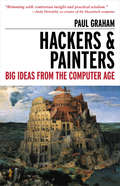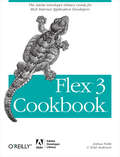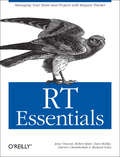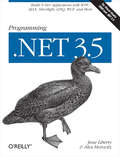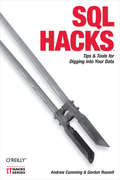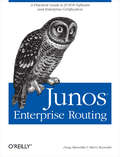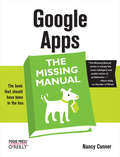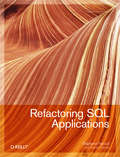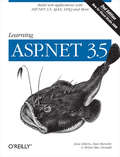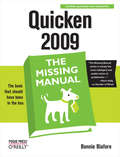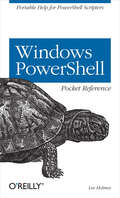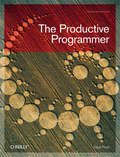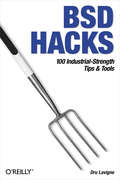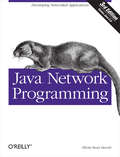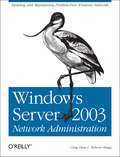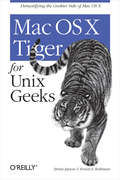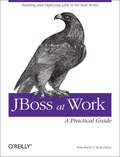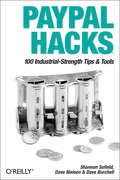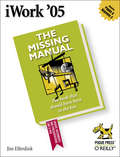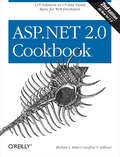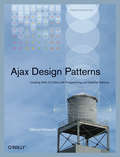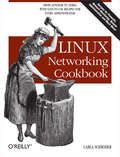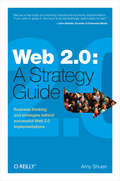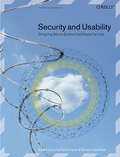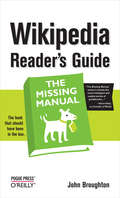- Table View
- List View
Hackers & Painters: Big Ideas from the Computer Age
by Paul Graham"The computer world is like an intellectual Wild West, in which you can shoot anyone you wish with your ideas, if you're willing to risk the consequences. " --from Hackers & Painters: Big Ideas from the Computer Age, by Paul Graham We are living in the computer age, in a world increasingly designed and engineered by computer programmers and software designers, by people who call themselves hackers. Who are these people, what motivates them, and why should you care? Consider these facts: Everything around us is turning into computers. Your typewriter is gone, replaced by a computer. Your phone has turned into a computer. So has your camera. Soon your TV will. Your car was not only designed on computers, but has more processing power in it than a room-sized mainframe did in 1970. Letters, encyclopedias, newspapers, and even your local store are being replaced by the Internet. Hackers & Painters: Big Ideas from the Computer Age, by Paul Graham, explains this world and the motivations of the people who occupy it. In clear, thoughtful prose that draws on illuminating historical examples, Graham takes readers on an unflinching exploration into what he calls "an intellectual Wild West." The ideas discussed in this book will have a powerful and lasting impact on how we think, how we work, how we develop technology, and how we live. Topics include the importance of beauty in software design, how to make wealth, heresy and free speech, the programming language renaissance, the open-source movement, digital design, internet startups, and more.
Flex 3 Cookbook: Code-Recipes, Tips, and Tricks for RIA Developers (Adobe Developer Library)
by Joshua Noble Todd AndersonThe best way to showcase a powerful new technology is to demonstrate its real-world results, and that's exactly what this new Cookbook does with Adobe Flex 3. Wide ranging and highly practical, Flex 3 Cookbook contains more than 300 proven recipes for developing interactive Rich Internet Applications and Web 2.0 sites. You'll find everything from Flex basics, to solutions for working with visual components and data access, to tips on application development, unit testing, and using Adobe AIR. You also get ideas from the development community. Through its Flex Cookbook website (www.adobe.com/devnet/), Adobe invited Flex developers to post their own solutions for working with this technology, and from hundreds of posts, the authors chose the best and most useful solutions to supplement Flex 3 Cookbook. Each recipe inside provides a solution to a common problem, explains how and why it works, and offers sample code that you can put to use immediately. Topics include:Containers and dialogues Working with Text Data driven components DataGrid and Advanced DataGrid ItemRenderers and Editors Images, bitmaps, videos, and sounds CSS, styling, and skinning States and effects Working with Collections, arrays, and DataProviders Using DataBinding Validation, formatting, and regular expressions Using Charts and data visualization Services and Data Access Using RSLs and Modules Working with Adobe AIR Whether you're a committed Flex developer or still evaluating the technology, you'll discover how to get quick results with Flex 3 using the recipes in this Cookbook. It's an ideal way to jumpstart your next web application.
RT Essentials: Managing Your Team and Projects with Request Tracker
by Dave Rolsky Darren Chamberlain Richard Foley Robert Spier Jesse VincentIn a typical organization, there's always plenty that to do such as: pay vendors, invoice customers, answer customer inquiries, and fix bugs in hardware or software. You need to know who wants what and keep track of what is left to do. This is where a ticketing system comes in. A ticketing system allows you to check the status of various tasks: when they were requested, who requested them and why, when they were completed, and more. RT is a high-level, open source ticketing system efficiently enabling a group of people to manage tasks, issues, and requests submitted by a community of users. RT Essentials, co-written by one of the RT's original core developers, Jesse Vincent, starts off with a quick background lesson about ticketing systems and then shows you how to install and configure RT. This comprehensive guide explains how to perform day-to-day tasks to turn your RT server into a highly useful tracking tool. One way it does this is by examining how a company could use RT to manage its internal processes. Advanced chapters focus on developing add-on tools and utilities using Perl and Mason. There's also chapter filled with suggested uses for RT inside your organization. No matter what kind of data your organization tracks--from sales inquiries to security incidents or anything in between--RT Essentials helps you use RT to provide order when you need it most.
Programming .NET 3.5: Build N-Tier Applications with WPF, AJAX, Silverlight, LINQ, WCF, and More
by Jesse Liberty Alex Horovitz.NET 3.5 will help you create better Windows applications, build Web Services that are more powerful, implement new Workflow projects and dramatically enhance the user's experience. But it does so with what appears to be a collection of disparate technologies. In Programming .NET 3.5, bestselling author Jesse Liberty and industry expert Alex Horovitz uncover the common threads that unite the .NET 3.5 technologies, so you can benefit from the best practices and architectural patterns baked into this newest generation of Microsoft frameworks. While single-topic .NET 3.5 books delve into Windows Presentation Foundation and the other frameworks in greater detail, Programming .NET 3.5 offers a "Grand Tour" of the release that describes how the four principal technologies can be used together, with Ajax, to build modern n-tier and service-oriented applications. Developers have struggled to implement these patterns with previous versions of the .NET Framework, but this hands-on guide uses real-world examples and fully annotated source code to demonstrate how .NET 3.5 can make it easy. The concepts and technologies that this book covers include: XAML -- Microsoft's new XML-based markup language for UI, used with WPF Windows Presentation Foundation (WPF) -- a new presentation framework and graphics subsystem for Windows that puts Vista-like effect in your grasp Ajax Windows Communication Foundation (WCF) - a new standards-based framework that enables applications to communicate across a network using a variety of protocols Workflow Foundation (WF) -- framework for defining, executing, and managing workflows CardSpace -- framework for managing the identities of your users You'll learn how to use each of the four frameworks alone and in concert to build a series of meaningful example applications. Examples are written in C#, and all of the source code will be available for download at both the O'Reilly and the authors' site, which offers access to a free support forum. Between them, authors Jesse Liberty and Alex Horovitz have nearly forty years of experience in delivering commercial applications for companies such as Citibank, Apple, AT&T, NeXt, PBS, Ziff Davis, and dozens of smaller organizations. Their combined experience is valuable for telling the story of .NET 3.5 and how it will shorten the development life cycle for applications developers, and enhance your productivity.
SQL Hacks: Tips & Tools for Digging Into Your Data
by Andrew Cumming Gordon RussellWhether you're running Access, MySQL, SQL Server, Oracle, or PostgreSQL, this book will help you push the limits of traditional SQL to squeeze data effectively from your database. The book offers 100 hacks -- unique tips and tools -- that bring you the knowledge of experts who apply what they know in the real world to help you take full advantage of the expressive power of SQL. You'll find practical techniques to address complex data manipulation problems. Learn how to: Wrangle data in the most efficient way possible Aggregate and organize your data for meaningful and accurate reporting Make the most of subqueries, joins, and unions Stay on top of the performance of your queries and the server that runs them Avoid common SQL security pitfalls, including the dreaded SQL injection attackLet SQL Hacks serve as your toolbox for digging up and manipulating data. If you love to tinker and optimize, SQL is the perfect technology and SQL Hacks is the must-have book for you.
JUNOS Enterprise Routing: A Practical Guide to JUNOS Software and Enterprise Certification
by Doug Marschke Harry ReynoldsWritten by the instructors and creators of the JNTCP-ER Certification Exams, JUNOS Enterprise Routing is the only comprehensive book for Juniper enterprise and edge routing environments. It offers complete coverage of all the services available to the JUNOS administrator, including JUNOS Enhanced Services (ES).<P> This book is the official study guide for all three Juniper Enterprise Routing certification exams, and is highly recommended reading to pass the exams. With its field-guide emphasis on practical solutions, you can easily take the book beyond the classroom and into working networks as a design, maintenance, and troubleshooting reference par excellence.<P> JUNOS Enterprise Routing covers all three certification exams in this track:<P> * Juniper Networks Certified Internet Associate (JNCIA-ER)<P> * Juniper Networks Certified Internet Specialist (JNCIS-ER)<P> * Juniper Networks Certified Internet Expert (JNCIE-ER)<P> With more services such as voice, conference, and multicast on the IP router platform, the market for enterprise routers is growing exponentially, and the need for certified engineers to keep up with network developments in protocols and security is paramount. For everyone who works with Juniper enterprise and edge routing environments, this is a must-have book.
Google Apps: The Missing Manual (Missing Manual)
by Nancy ConnerAmong its many amazing applications, Google now has web-based alternatives to many of the applications in Microsoft Office. This comprehensive and easy-to-follow new book enables you to explore Google's new office applications in detail. Once you do, you'll be in good company -- more than 100,000 small businesses and some corporations are already looking to take advantage of these free Google offerings.Google Apps: The Missing Manual teaches you how to use three relatively new applications from Google: "Docs and Spreadsheets", which provide many of the same core tools that you find in Word and Excel; and Google Calendar and Gmail, the applications that offer an alternative to Outlook. This book demonstrates how these applications together can ease your ability to collaborate with others, and allow you access to your documents, mail and appointments from any computer at any location. Of course, as remarkable as these applications are, Google's office suite is definitely a work-in-progress. Navigating what you can and can't do and -- more importantly -- understanding how to do it isn't always easy. And good luck finding enough help online. Google Apps: The Missing Manual is the one book you need to get the most out of this increasingly useful part of the Google empire. This book: Explains how to create, save and share each of Google's web-based office applications Offers separate sections for Docs and Spreadsheets, Google Calendar, and Gmail Demonstrates how to use these applications in conjunction with one another Gives you crystal-clear and jargon-free explanations that will satisfy users of all technical levels Many of you already use Gmail, but do you know its full potential? Do you know how you can increase its power by using Gmail with Doc and Spreadsheets and Google Calendar? You'll find out with Google Apps: The Missing Manual. You'll also come to understand why large corporations such as General Electric and Proctor & Gamble are taking a long, hard look at these applications.
Refactoring SQL Applications
by Stephane Faroult Pascal L'HermiteWhat can you do when database performance doesn't meet expectations? Before you turn to expensive hardware upgrades to solve the problem, reach for this book. Refactoring SQL Applications provides a set of tested options for making code modifications to dramatically improve the way your database applications function. Backed by real-world examples, you'll find quick fixes for simple problems, in-depth answers for more complex situations, and complete solutions for applications with extensive problems. Learn to:Determine if and where you can expect performance gains Apply quick fixes, such as limiting calls to the database in stored functions and procedures Refactor tasks, such as replacing application code by a stored procedure, or replacing iterative, procedural statements with sweeping SQL statements Refactor flow by increasing parallelism and switching business-inducted processing from synchronous to asynchronous Refactor design using schema extensions, regular views, materialized views, partitioning, and more Compare before and after versions of a program to ensure you get the same results once you make modifications Refactoring SQL Applications teaches you to recognize and assess code that needs refactoring, and to understand the crucial link between refactoring and performance. If and when your application bogs down, this book will help you get it back up to speed.
Learning ASP.NET 3.5: Build Web Applications with ASP.NET 3.5, AJAX, LINQ, and More
by Jesse Liberty Dan Hurwitz Brian MacdonaldWith this book, you will learn how to create engaging and interactive web applications using the latest version of the world's most popular web development platform: ASP.NET with AJAX, built on the productivity-enhancing features of Visual Studio 2008. All you need to get started is a basic knowledge of HTML and a desire to produce professional quality websites.Learning ASP.NET 3.5 introduces new skills in each new chapter and offers fully annotated and fully functional examples that you can put to work immediately. Each chapter adds detailed summaries, practice questions to ensure comprehension, and exercises so you can apply what you've learned to new situations. Written by the bestselling author team of Jesse Liberty, Dan Hurwitz, and Brian MacDonald, Learning ASP.NET 3.5 offers complete, up-to-date coverage of ASP.NET 3.5 and AJAX. The book includes:Chapters that are designed as a series of tutorials on different aspects of web development Examples in each chapter that illustrate how a new concept works. Different chapters feature either a single running example with several stages, or a series of smaller examples A single large example in the final chapter offers that uses everything the reader has learned VB, JavaScript, and SQL Cheat Sheet sidebars to help readers with no little or no background with those topics AJAX-style fully integrated into ASP.NET programming -- the way it should be taught and used If you want to get up to speed with the world's most popular web development technology, Learning ASP.NET 3.5 is the best resource for the job.
Quicken 2009: The Missing Manual (Missing Manual)
by Bonnie BiaforeQuicken is a convenient way to keep track of personal finances, but many people are unaware of Quicken's power and end up using only the basic features. Sometimes Quicken raises more questions than it answers: Return of capital from stock? Net worth? What are they and why do you need to know about them? Luckily, Quicken 2009: The Missing Manual picks up where Quicken's help resources leave off. You'll find step-by-step instructions for using Quicken on your Windows PC, including useful features such as budgeting, recording investment transactions, and archiving Quicken data files. You also learn why and when to use specific features, and which ones would be most useful in a given situation. This book helps you:Set up Quicken to take care of your specific needs Follow your money from the moment you earn it Make deposits, pay for expenses, and track the things you own and how much you owe Take care of financial tasks online, and quickly reconcile your accounts Create and use budgets and track your investments Generate reports to prepare your tax returns and evaluate your financial fitness And a lot more. Quicken 2009: The Missing Manual accommodates readers at every technical level, whether you're a first-time or advanced Quicken user. For a topic as important as your personal finances, why trust anything else?
Windows Powershell Pocket Reference (Pocket Reference (O'Reilly))
by Lee HolmesThis portable reference to Windows PowerShell summarizes both the command shell and scripting language, and provides a concise reference to the major tasks that make PowerShell so successful. It's an ideal on-the-job tool for Windows administrators who don't have time to plow through huge books or search online.Written by Microsoft PowerShell team member Lee Holmes, and excerpted from his Windows PowerShell Cookbook, Windows PowerShell Pocket Reference offers up-to-date coverage of PowerShell's 1.0 release. You'll find information on .NET classes and legacy management tools that you need to manage your system, along with chapters on how to write scripts, manage errors, format output, and much more. Beginning with a whirlwind tour of Windows PowerShell, this convenient guide covers: PowerShell language and environmentRegular expression referencePowerShell automatic variablesStandard PowerShell verbsSelected .NET classes and their usesWMI referenceSelected COM objects and their uses.NET string formatting.NET datetime formattingAn authoritative source of information about PowerShell since its earliest betas, Lee Holmes' vast experience lets him incorporate both the "how" and the "why" into the book's discussions. His relationship with the PowerShell and administration community -- through newsgroups, mailing lists, and his informative blog Lee Holmes -- gives him insight into problems faced by administrators and PowerShell users alike.If you're ready to learn this powerful tool without having to break stride in your routine, this is the book you want.
The Productive Programmer (Theory in Practice (O'Reilly))
by Neal FordAnyone who develops software for a living needs a proven way to produce it better, faster, and cheaper. The Productive Programmer offers critical timesaving and productivity tools that you can adopt right away, no matter what platform you use. Master developer Neal Ford not only offers advice on the mechanics of productivity-how to work smarter, spurn interruptions, get the most out your computer, and avoid repetition-he also details valuable practices that will help you elude common traps, improve your code, and become more valuable to your team. You'll learn to: Write the test before you write the code Manage the lifecycle of your objects fastidiously Build only what you need now, not what you might need later Apply ancient philosophies to software development Question authority, rather than blindly adhere to standards Make hard things easier and impossible things possible through meta-programming Be sure all code within a method is at the same level of abstraction Pick the right editor and assemble the best tools for the job This isn't theory, but the fruits of Ford's real-world experience as an Application Architect at the global IT consultancy ThoughtWorks. Whether you're a beginner or a pro with years of experience, you'll improve your work and your career with the simple and straightforward principles in The Productive Programmer .
BSD Hacks: 100 Industrial Tip & Tools
by Dru LavigneIn the world of Unix operating systems, the various BSDs come with a long heritage of high-quality software and well-designed solutions, making them a favorite OS of a wide range of users. Among budget-minded users who adopted BSD early on to developers of some of today's largest Internet sites, the popularity of BSD systems continues to grow. If you use the BSD operating system, then you know that the secret of its success is not just in its price tag: practical, reliable, extraordinarily stable and flexible, BSD also offers plenty of fertile ground for creative, time-saving tweaks and tricks, and yes, even the chance to have some fun. "Fun?" you ask. Perhaps "fun" wasn't covered in the manual that taught you to install BSD and administer it effectively. But BSD Hacks, the latest in O'Reilly's popular Hacks series, offers a unique set of practical tips, tricks, tools--and even fun--for administrators and power users of BSD systems. BSD Hacks takes a creative approach to saving time and getting more done, with fewer resources. You'll take advantage of the tools and concepts that make the world's top Unix users more productive. Rather than spending hours with a dry technical document learning what switches go with a command, you'll learn concrete, practical uses for that command. The book begins with hacks to customize the user environment. You'll learn how to be more productive in the command line, timesaving tips for setting user-defaults, how to automate long commands, and save long sessions for later review. Other hacks in the book are grouped in the following areas:Customizing the User Environment Dealing with Files and Filesystems The Boot and Login Environments Backing Up Networking Hacks Securing the System Going Beyond the Basics Keeping Up-to-Date Grokking BSD If you want more than your average BSD user--you want to explore and experiment, unearth shortcuts, create useful tools, and come up with fun things to try on your own--BSD Hacks is a must-have. This book will turn regular users into power users and system administrators into super system administrators.
Java Network Programming
by Elliotte Rusty HaroldThe new third edition of this highly regarded introduction to Java networking programming has been thoroughly revised to cover all of the 100+ significant updates to Java Developers Kit (JDK) 1.5. It is a clear, complete introduction to developing network programs (both applets and applications) using Java, covering everything from networking fundamentals to remote method invocation (RMI).Java Network Programming, 3rd Edition includes chapters on TCP and UDP sockets, multicasting protocol and content handlers, servlets, multithreaded network programming, I/O, HTML parsing and display, the Java Mail API, and the Java Secure Sockets Extension. There's also significant information on the New I/O API that was developed in large part because of the needs of network programmers.This invaluable book is a complete, single source guide to writing sophisticated network applications. Packed with useful examples, it is the essential resource for any serious Java developer.
Windows Server 2003 Network Administration: Building and Maintaining Problem-Free Windows Networks
by Craig Hunt Roberta BraggThis book is the Windows Server version of the classic TCP/IP Network Administration. Like the book that inspired it, Windows Server 2003 Network Administration provides an overview of the essential TCP/IP protocols, and explains how to properly manage and configure the services based on these protocols. Any skilled network administrator knows that understanding how things work is as important as knowing how things are done. This book is the essential guide to both, containing everything a network administrator needs to exchange information via the Internet, and to build effective reliable networks. This must-read guide is divided into three distinct sections: fundamental concepts, tutorial, and reference. The first three chapters are a basic discussion of the network protocols and services. This discussion provides the fundamental concepts necessary to understand the rest of the book. The remaining chapters provide a how-to tutorial for planning, installing and configuring various important network services. The book concludes with three appendixes that are technical references for various configuration options. Content specifics include how to: Install, configure, and manage a Microsoft DNS and Windows DHCP server Control remote communications with Microsoft RRAS software Protect hosts with Internet Connection Firewalls Configure Internet and Intranet Web services with IIS Design proper security into your network Troubleshoot the network when problems develop After you've turned the final page of Windows Server 2003 Network Administration, you'll not only understand how to network, but also why it needs to be done.
Mac OS X Tiger for Unix Geeks
by Brian Jepson Ernest E RothmanThe power and capabilities of Mac OS X have generated a great deal of interest from Unix developers, Java developers, and Unix system administrators. These communities are now looking to Mac OS X to satisfy their everyday computing needs. But they need help finding the correspondences between the Unix they are accustomed to and the Unix that sits under Mac OS X's hood. This handy reference helps readers acclimate themselves to this familiar, yet foreign, Unix environment. Completely revised and updated to cover the newest release of Mac OS X, "Tiger" this is the book command-line fans chose over and over to get them up and running with the latest version of the Mac operating system.
JBoss at Work: A Practical Guide
by Scott Davis Tom MarrsConsisting of a number of well-known open source products, JBoss is more a family of interrelated services than a single monolithic application. But, as with any tool that's as feature-rich as JBoss, there are number of pitfalls and complexities, too. Most developers struggle with the same issues when deploying J2EE applications on JBoss: they have trouble getting the many J2EE and JBoss deployment descriptors to work together; they have difficulty finding out how to get started; their projects don't have a packaging and deployment strategy that grows with the application; or, they find the Class Loaders confusing and don't know how to use them, which can cause problems. JBoss at Work: A Practical Guide helps developers overcome these challenges. As you work through the book, you'll build a project using extensive code examples. You'll delve into all the major facets of J2EE application deployment on JBoss, including JSPs, Servlets, EJBs, JMS, JNDI, web services, JavaMail, JDBC, and Hibernate. With the help of this book, you'll: Implement a full J2EE application and deploy it on JBoss Discover how to use the latest features of JBoss 4 and J2EE 1.4, including J2EE-compliant web services Master J2EE application deployment on JBoss with EARs, WARs, and EJB JARs Understand the core J2EE deployment descriptors and how they integrate with JBoss-specific descriptors Base your security strategy on JAAS Written for Java developers who want to use JBoss on their projects, the book covers the gamut of deploying J2EE technologies on JBoss, providing a brief survey of each subject aimed at the working professional with limited time. If you're one of the legions of developers who have decided to give JBoss a try, then JBoss at Work: A Practical Guide is your next logical purchase. It'll show you in plain language how to use the fastest growing open source tool in the industry today. If you've worked with JBoss before, this book will get you up to speed on JBoss 4, JBoss WS (web services), and Hibernate 3.
PayPal Hacks: 100 Industrial-Strength Tips & Tools (Hacks)
by Shannon Sofield Dave Nielsen Dave BurchellIf you've bought or sold items through eBay, or through hundreds of other online sites, then you're familiar with PayPal, the online payment service. With PayPal, a valid email address, and a credit card or bank account, you can easily send and receive payments online. Not a bank or financial institution itself, PayPal describes its service as one that builds on the financial infrastructure of bank accounts and credit cards, and using advanced propriety fraud prevention systems, creates a safe, global, real-time payment solution. Put simply, PayPal provides the means for people to conduct financial transactions online, instantly and securely. But there's more to PayPal than meets the eye. PayPal Hacks shows you how to make the most of PayPal to get the most out of your online business or transactions. Authors Shannon Sofield of Payloadz.com and PayPal evangelist David Nielsen guide you through the rigors of using and developing with PayPal. Whether you're building an ecommerce site using PayPal as a transaction provider, or simply trying to pay for an eBay auction without getting burned, PayPal Hacks will give you the skinny on this leading global online payment service. The collection of tips and tricks in PayPal Hacks shows you how to find or even build the right tools for using PayPal to buy and sell on eBay or as a transaction provider for ecommerce on your own site. Written for all PayPal users, from those just starting out to those developing sophisticated ecommerce sites, this book begins with the basics such as setting up your account, then moves quickly into specific tips and tools for buyers, sellers, and developers. With PayPal Hacks, you can:Learn extra steps to help protect yourself while buying or selling on eBay Save time and money with advanced tips and undocumented features Learn dozens of easy-to-follow procedures to help you request and receive payments and fill orders Use PayPal to handle subscriptions, affiliate systems, and donations Create and customize your customers' checkout process Effortlessly integrate PayPal's shopping cart system into your own website Implement digital fulfillment with Instant Payment Notification (IPN) and Payment Data Transfer (PDT) Develop and distribute ecommerce applications with the PayPal API Each hack consists of a task to be accomplished or a creative solution to a problem, presented in a clear, logical, and task-oriented format. PayPal Hacks provides the tools and details necessary to make PayPal more profitable, more flexible, and more convenient.
iWork '05: The Missing Manual (Missing Manual)
by Jim ElferdinkIntroduced by Apple in January 2005, iWork '05 is an innovative new suite of document and presentation software that's the same caliber as Apple's groundbreaking digital media applications and that's wholly dedicated to what Mac users like you care about most: artistry and creativity. iWork '05 isn't about "office productivity"--it's about creating slick and stylish documents and cinema-quality digital presentations that say precisely what you want them to say. While iWork '05 helps you create stunning documents and presentations, the suite doesn't come with any in-depth documentation of its own. That's where iWork '05: The Missing Manual comes in. The book that should have been in the box, it gives you everything you need to master iWork '05. Seamlessly integrated with the wildly popular iLife '05 and designed to take advantage of the advanced typography and graphics engine of Mac OS X, iWork is actually two separate programs: Pages and Keynote 2. Pages is a brand-new, streamlined word processor and page layout program that allows nonprofessionals to quickly and painlessly produce gorgeous brochures, newsletters, letters, invitations, product data sheets, and more. You can start documents from scratch or use one of the 40 professionally designed templates as a starting point. Keynote 2 is a significant upgrade to Keynote, Apple's PowerPoint-like presentation software that allows you to build unique presentations, demonstrations, storyboard animations, interactive slideshows, and more. Like every Missing Manual, this one is refreshingly entertaining and scrupulously detailed. iWork '05: The Missing Manual gives you all the essentials of Pages and Keynote 2, including an objective look at each program's capabilities, its advantages over similar programs, and its limitations. The book delivers countless goodies that you won't find anywhere else: undocumented tips, tricks, and secrets for getting the very best results from both exciting new applications. With the iWork '05 suite and iWork '05: The Missing Manual, you are totally equipped to give your work the style it deserves.
ASP.NET 2.0 Cookbook: 125 Solutions in C# and Visual Basic for Web Developers (Cookbooks (O'Reilly))
by Geoffrey T. Leblond Michael A KittelCompletely revised for ASP.NET 2.0, this new edition of the best-selling ASP.NET Cookbook has everything you need to go from beginning to advanced Windows-based web site development using Microsoft's popular Visual Studio 2005 and ASP.NET 2.0 developer tools. Written for the impatient professional, ASP.NET 2.0 Cookbook contains more than 125 recipes for solving common and not-so-common problems you are likely to encounter when building ASP.NET-based web applications. The recipes in this book, which run the gamut from simple coding techniques to more comprehensive development strategies, are presented in the popular Problem-Solution-Discussion format of the O'Reilly Cookbook series. As with the first edition, every solution is coded in both C# and Visual Basic 2005. Among the additions and revisions to this new edition are: Three new chapters, including 25 new recipes for Master and Content pages, Personalization using Profiles and Themes, Custom Web Parts, and more New code for every solution, rewritten to take advantage of features and techniques new to ASP.NET 2.0 and available for download The ASP.NET 2.0 Cookbook continues to provide the most comprehensive coverage you'll find anywhere of: Tabular controls, including the new GridView control Data validation, including the new ASP.NET 2.0 validation controls, as well as techniques for performing your own validation programmatically User and custom controls Error handling, performance tuning, and caching Whether you're new to ASP.NET or an experienced Microsoft developer, with ASP.NET 2.0 Cookbook, deliverance from a long day (or night) at your computer could be just one recipe away.
Ajax Design Patterns: Creating Web 2.0 Sites with Programming and Usability Patterns
by Michael MahemoffAjax, or Asynchronous JavaScript and XML, exploded onto the scene in the spring of 2005 and remains the hottest story among web developers. With its rich combination of technologies, Ajax provides a strong foundation for creating interactive web applications with XML or JSON-based web services by using JavaScript in the browser to process the web server response. Ajax Design Patterns shows you best practices that can dramatically improve your web development projects. It investigates how others have successfully dealt with conflicting design principles in the past and then relays that information directly to you. The patterns outlined in the book fall into four categories: Foundational technology: Examines the raw technologies required for Ajax development Programming: Exposes techniques that developers have discovered to ensure their Ajax applications are maintainable Functionality and usability: Describes the types of user interfaces you'll come across in Ajax applications, as well as the new types of functionality that Ajax makes possible Development: Explains the process being used to monitor, debug, and test Ajax applications Ajax Design Patterns will also get you up to speed with core Ajax technologies, such as XMLHttpRequest, the DOM, and JSON. Technical discussions are followed by code examples so you can see for yourself just what is-and isn't-possible with Ajax. This handy reference will help you to produce high-quality Ajax architectures, streamline web application performance, and improve the user experience. Michael Mahemoff holds a PhD in Computer Science and Software Engineering from the University of Melbourne, where his thesis was "Design Reuse in Software Engineering and Human-Computer Interaction." He lives in London and consults on software development issues in banking, health care, and logistics. "Michael Mahemoff's Ajax Design Patterns is a truly comprehensive compendium of web application design expertise, centred around but not limited to Ajax techniques. Polished nuggets of design wisdom are supported by tutorials and real-world code examples resulting in a book that serves not only as an intermediate to expert handbook but also as an extensive reference for building rich interactive web applications." --Brent Ashley, remote scripting pioneer
Linux Networking Cookbook: From Asterisk to Zebra with Easy-to-Use Recipes (Linux)
by Carla SchroderThis soup-to-nuts collection of recipes covers everything you need to know to perform your job as a Linux network administrator, whether you're new to the job or have years of experience. With Linux Networking Cookbook, you'll dive straight into the gnarly hands-on work of building and maintaining a computer network. Running a network doesn't mean you have all the answers. Networking is a complex subject with reams of reference material that's difficult to keep straight, much less remember. If you want a book that lays out the steps for specific tasks, that clearly explains the commands and configurations, and does not tax your patience with endless ramblings and meanderings into theory and obscure RFCs, this is the book for you. You will find recipes for: Building a gateway, firewall, and wireless access point on a Linux network Building a VoIP server with Asterisk Secure remote administration with SSH Building secure VPNs with OpenVPN, and a Linux PPTP VPN server Single sign-on with Samba for mixed Linux/Windows LANs Centralized network directory with OpenLDAP Network monitoring with Nagios or MRTG Getting acquainted with IPv6 Setting up hands-free networks installations of new systems Linux system administration via serial console And a lot more. Each recipe includes a clear, hands-on solution with tested code, plus a discussion on why it works. When you need to solve a network problem without delay, and don't have the time or patience to comb through reference books or the Web for answers, Linux Networking Cookbook gives you exactly what you need.
Web 2.0: Business thinking and strategies behind successful Web 2.0 implementations.
by Amy ShuenWeb 2.0 makes headlines, but how does it make money? This concise guide explains what's different about Web 2.0 and how those differences can improve your company's bottom line. Whether you're an executive plotting the next move, a small business owner looking to expand, or an entrepreneur planning a startup, Web 2.0: A Strategy Guide illustrates through real-life examples how businesses, large and small, are creating new opportunities on today's Web. This book is about strategy. Rather than focus on the technology, the examples concentrate on its effect. You will learn that creating a Web 2.0 business, or integrating Web 2.0 strategies with your existing business, means creating places online where people like to come together to share what they think, see, and do. When people come together over the Web, the result can be much more than the sum of the parts. The customers themselves help build the site, as old-fashioned "word of mouth" becomes hypergrowth.Web 2.0: A Strategy Guide demonstrates the power of this new paradigm by examining how: Flickr, a classic user-driven business, created value for itself by helping users create their own value Google made money with a model based on free search, and changed the rules for doing business on the Web-opening opportunities you can take advantage ofSocial network effects can support a business-ever wonder how FaceBook grew so quickly? Businesses like Amazon tap into the Web as a source of indirect revenue, using creative new approaches to monetize the investments they've made in the Web Written by Amy Shuen, an authority on Silicon Valley business models and innovation economics, Web 2.0: A Strategy Guide explains how to transform your business by looking at specific practices for integrating Web 2.0 with what you do. If you're executing business strategy and want to know how the Web is changing business, this book is for you.
Security and Usability: Designing Secure Systems that People Can Use
by Simson Garfinkel Lorrie Faith CranorHuman factors and usability issues have traditionally played a limited role in security research and secure systems development. Security experts have largely ignored usability issues--both because they often failed to recognize the importance of human factors and because they lacked the expertise to address them. But there is a growing recognition that today's security problems can be solved only by addressing issues of usability and human factors. Increasingly, well-publicized security breaches are attributed to human errors that might have been prevented through more usable software. Indeed, the world's future cyber-security depends upon the deployment of security technology that can be broadly used by untrained computer users. Still, many people believe there is an inherent tradeoff between computer security and usability. It's true that a computer without passwords is usable, but not very secure. A computer that makes you authenticate every five minutes with a password and a fresh drop of blood might be very secure, but nobody would use it. Clearly, people need computers, and if they can't use one that's secure, they'll use one that isn't. Unfortunately, unsecured systems aren't usable for long, either. They get hacked, compromised, and otherwise rendered useless. There is increasing agreement that we need to design secure systems that people can actually use, but less agreement about how to reach this goal. Security & Usability is the first book-length work describing the current state of the art in this emerging field. Edited by security experts Dr. Lorrie Faith Cranor and Dr. Simson Garfinkel, and authored by cutting-edge security and human-computer interaction (HCI) researchers world-wide, this volume is expected to become both a classic reference and an inspiration for future research. Security & Usability groups 34 essays into six parts: Realigning Usability and Security---with careful attention to user-centered design principles, security and usability can be synergistic. Authentication Mechanisms-- techniques for identifying and authenticating computer users. Secure Systems--how system software can deliver or destroy a secure user experience. Privacy and Anonymity Systems--methods for allowing people to control the release of personal information. Commercializing Usability: The Vendor Perspective--specific experiences of security and software vendors (e.g., IBM, Microsoft, Lotus, Firefox, and Zone Labs) in addressing usability. The Classics--groundbreaking papers that sparked the field of security and usability. This book is expected to start an avalanche of discussion, new ideas, and further advances in this important field.
Wikipedia Reader's Guide: The Missing Manual
by John BroughtonYou don't have to understand how to edit Wikipedia in order to find the information you need and join the conversation. This booklet gives you just what you need to know in friendly, concise form so you can research any subject without getting lost in Wikipedia's labyrinth. With it, you'll be able to unlock the mysteries of the many links on every Wikipedia page and the sometimes cryptic buzzwords you see on Talk pages. And, while this booklet focuses on Wikipedia readers, it also includes a tutorial for first-time editors and explains Wikipedia's editing tools. You'll find valuable advice on how to alert editors to flaws in articles and how to contribute to Talk pages without getting caught up in pointless disputes. The author of Wikipedia Reader's Guide: The Missing Manual has edited more than 15,000 Wikipedia articles, and has written a comprehensive index to Wikipedia for editors to use in their daily work. His knowledge of Wikipedia is limitless and his passion is contagious. With this guide, you'll catch on quickly.
